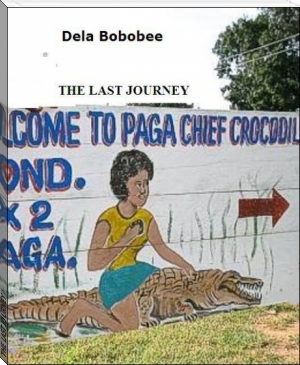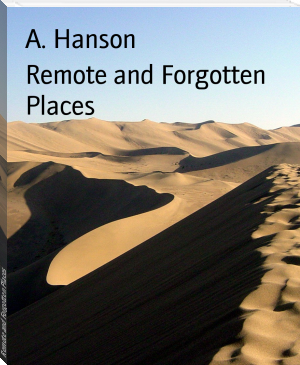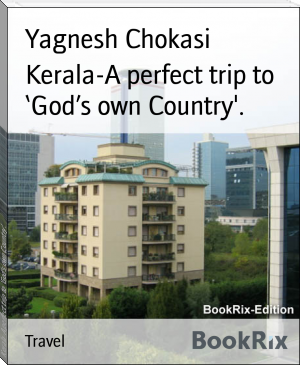THE LAST JOURNEY - Dela Bobobee (best ebook reader ubuntu txt) 📗

- Author: Dela Bobobee
Book online «THE LAST JOURNEY - Dela Bobobee (best ebook reader ubuntu txt) 📗». Author Dela Bobobee
THE LAST JOURNEY
The mere thought of travelling to the village of Paga filled me with some unexplainable overflow of exhilaration. I knew that the journey from Boabeng-Fiemma to Paga in the northern part of the Ghanaian country would no longer be that long, and I looked forward to it as if I have won a rare chance to travel to an exotic paradise. I wondered what could be the reason for my blissful excitement. Could it be the thought of the chance to take photographs holding a live crocodile by the tail or just the thrills of adventure? Or perhaps I was still basking in the aftermath of a blissful euphoria from the experiences of my recent visit to the Boabeng-Fiemma Monkey Sanctuary. Yes, that trip was one kind of a thrilling experience. I know that not many people are this fortunate to travel to all these exotic places, and so just sit back and enjoy my travel stories. Perhaps you may be stimulated to someday travel to these places and see for yourselves first-hand what I always regard as really fascinating travel stories. I decided to visit the Boabeng-Fiemma Monkey Sanctuary and the Paga Crocodile Ponds because of the fascinating stories I have heard about these places. First of all, I travelled to Boabeng-Fiemma.
Boabeng-Fiemma Monkey Sanctuary
The twin towns of Boabeng and Fiemma are located in the West African Ghanaian communities which are famous among tourists for their extremely friendly monkeys. Boabeng and Fiema are villages in the Brong Ahafo Region of Ghana. To reach this place I first travelled from Accra to Kumasi. Kumasi is the capital of Ashanti Region which is world famous for its gold and locally woven Kente cloths. From Kumasi, I took a bus going on the northern route to Tamale until I reached Techiman which was about 100 km from Kumasi. From Techiman, I took another bus to Nkoranza. In Nkoranza, I asked for directions to Fiemma. I found out that the road soon became a dirt road.
I travelled to Boabeng-Fiemma not in a private car but in a rickety local commercial bus called “Tro-Tro”, and I guess apart from the dusty road and the pot holes, the wobbly ride really added to the fun of the trip. We bypassed a group of European tourists taking a leisurely ride through the rather bumpy road. When the local passengers spotted them they waved excitedly at them in greeting. And when the tourists waved back at them they became very happy and started shouting “Obroni, Obroni”, that is the name for whites in the local Akan dialect. Where the road split in the town, I noticed the tourist’s guest-house and park office on the left hand side. The journey took about six hours to reach there. Since the monkeys are usually spotted more in the mornings and evenings; I decided to spend the night there in the guest house which had good basic amenities. I had a fitful sleep and was woken up in the morning by the shrill chattering noise of the monkeys calling in the trees. I quickly got myself ready for seeing the monkeys after which I would continue my journey to Paga to visit the world famous Crocodile Ponds.
For now, let me tell you more details of my visit to the Boabeng-Fiemma Monkey Sanctuary. I quickly took my breakfast and went out to survey the environment. I heard sounds and movements and when I looked up I was delighted to see some monkeys that came to the guest house. They were not afraid of me when they saw me; they just regarded me coolly and continued on their way. Some were walking on the roof of the quest house.
I was later joined by a handful of Europeans and local tourists who came there on their first visits too. They got there before me but were waiting for the guide to be ready to take them round on the bush trails within the sanctuary. It was in the morning and one could hear the shrill chattering noise of the monkeys calling in the trees. The monkey sanctuary consists of a triangular-shaped forest bounded by roads and the twin towns of Boabeng and Fiemma. This Boabeng-Fiemma Monkey Sanctuary is a very unique one in the sense that not only are the monkeys here allowed to roam freely as they like in their natural habitat; they are also regarded by the inhabitants of these two towns as sacred and as their family relations. The monkeys live in harmony with the villagers and are seen as equals. They even get a real funeral when they die. Indeed monkeys around the world do not enjoy this status. There are two types of species of monkeys found in this sanctuary, the Campbell's Mona and the Geoffrey’s Black and White Colobus monkeys.
We paid some fees and were charged extra money to buy peanuts to entice the monkeys to come closer to us. We were later accompanied by a very polite guide who spoke good English, and patiently answered all our questions. He pointed out the physical descriptions, characteristics and the differences in the behaviours of the monkeys. There were about 700 Mona monkeys in the Sanctuary. They are brownish and omnivorous. The Black and White Geoffrey’s Columbus monkeys numbered about 500. They are vegetarians, living on leaves mainly. The small Mona monkeys are the least shy. They came very close to us and even ate peanuts out of our hands, but the Black and White Colobus monkey was harder to spot. Although we were able to see them in the trees eating leaves, they stayed away at a safe distance and were not enticed by our cajoling and insistent offer of peanuts. It did not take us long to comb the entire forest for it was very small. It took us about one and half hours to cover all the tracks.
We also decided to visit the two villages and we were lucky to see some monkeys running around freely in the streets in the company of other domestic livestock. I saw a monkey taking a jolly ride on the back of a sheep. Some of the monkeys were actually rolling in friendly frolics with some cats and dogs. I even saw some of these friendly monkeys “stealing”, nay, eating from pots unmolested, or perhaps they were purposely reserved for them by the villagers who regard them as part of them. It was fun to see these monkeys outside the zoos. We took some great pictures and got about three feet from a Mona monkey in the village while it perched on a low bough to eagerly munch a giant guava.
When the kids saw the European tourists in one of the villages they started greeting and waving at them, and when they waved them back they became very happy and embolden to come closer and started chanting “Obroni, picture! Picture! Picture.” One of the white men turned to me in awe, “Oh my God, how on earth did these kids got to know that my name is Peter?” I roared with laughter when I realized his mistake. Although the way the kids pronounced the word “picture” sounded like “Peter”, they were actually asking for the tourists to take shots of photographs of them. When he later got the understanding and nodded his head to them in acquiesce, the kids ran and came in groups to pose for the tourists to snap them some photographs. They were very happy and showed their appreciation by clapping and singing for the tourists who were repeatedly asking me for translations, as is I had presently become their official interpreter of the tour.
Just as in almost every part of indigenous African communities where some animal species are considered by the natives as sacred, there must be some totemic relationship behind that encounter between humans and animals. So also is the historical account of the genesis of this relationship full of such local folklore.
The Boabeng-Fiemma Monkey Sanctuary typifies traditional African conservation, the Ghanaian way. Here the culture of the people has been fashioned to include the acceptance of the monkeys as part of the society. The two communities came together in 1975 to pass a byelaw, prohibiting harm to the monkeys. They revere the animals with the belief that the monkeys are the children of the God of the twin-community. A visitor to the Sanctuary in the early morning would certainly hear monkeys calling loudly to one another.
The Sacred Crocodile Ponds of Paga
At first I thought perhaps it was the opportunity to be close to nature that was responsible for my heightened excitement. But I was wrong. The feeling was more than just an excitement. It goes beyond the thrills of adventure. I never knew it would end up being the most memorable journey into being, the very essence of life that is intrinsically imbedded in the intricacies of human nature.
It was a rare charisma to see the other side of nature. I have heard a lot of fantastic stories told about the friendly sacred crocodile sanctuary in the ancient village of Paga but I was not prepared for the intensity of the revelations that resulted from my last journey into human existence. Paga is well known for its friendly crocodiles that for decades have been living in perfect natural harmony with their human co-inhabitants. Now I invite you to share with me the thrills of this wonderful journey into nature.
The journey from Boabeng-Fiemma to Paga was not that far. Paga is a border town in the Kassena Nankana District of the Upper East Region of Ghana. I travelled in the company of a handful of tourists going to Paga. We departed very early from Boabeng-Fiemma so as to be able to reach our destination in time. The vehicle was in a very good condition and so we got there in time. All the fatigue and anticipation came to a climax when we finally arrived at Paga. The joyous and exhilarating atmosphere that greeted us upon arrival there was like a soothing balm to our aching limbs. We were told that the people of Paga were preparing for their yearly festival. We were greeted in the local Kasem dialect: "Baa na Paga ama ayi ana apa atiti. Nabiina bam laga badona.," meaning “Come to Paga and see for yourself; the people are friendly.”
Not only are the people of Paga friendly, their co-inhabitants in form of giant Nile crocodiles are also world known for their unusual friendliness. Paga is famous for its friendly crocodiles. Yes, friendly crocodiles! I have seen a lot of photographs taken by tourists touching, squatting, sitting, and standing near the crocodiles. Some are seen holding the tails; some bold ones were even seen shaking hands with the crocs. But with all these incredible photographs I have seen, live videos I have watched and the tourist articles I have read on the internet websites about these Paga friendly crocodiles, they were nothing compared to what I witnessed there. What I witnessed there surpassed all my wildest imaginations. I saw half naked little children riding joyfully and unharmed on the back of giant live Nile crocodiles in a pond that is situated in the middle of the town. Just as you often see expert divers swimming in the oceans together with dolphins, so do the people of Paga swim together in the sacred crocodile ponds unharmed. There is no known record of any crocodile attack or tragic incident in these Paga Crocodile Ponds.
As if by mutual tradition, Paga town was kept very clean. There is no eyesore in form of flying papers, debris, filth or environmental degradation. Perhaps this is a perfect example of cleanliness being next to godliness. God is certainly pleased with the people of Paga to give them a rare





Comments (0)